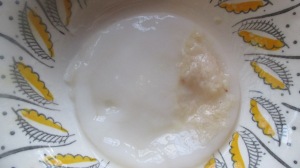Jun. The mysterious Kombucha relative that thrives, not on black tea and white sugar, but on green tea and raw honey. Mythically Tibetan, though not documented with any credibility– even if explications of the culturing bacteria are alluring and romantic.
I read this Nourished Kitchen how-to and felt full of curiousity and excitement. But how was I, in mid-Wales, to acquire the culture? Seemed like an effort I wouldn’t make.
Meanwhile… I’ve been sorting through all the weird stuff clogging fridge and counter space. And I finally got around to a months-old promise of posting out some cultures of Water Kefir, Kefir and Kombucha to some friends.
My Water Kefir had been sitting variously in the fridge and on the counter of my cool kitchen. Fairly abandoned, I haven’t been actively culturing any drinks with those grains for months, maybe actually since that post in June, 7 months ago. I’ve been feeling very positive that all my scrap vinegars now generate their own “mothers,” developed as they were without any original visible cultures. Whatever now sat in the Water Kefir jar was very acidified, as time will make it.
With great interest and a sense of pride, I noticed that my over-acidified Water Kefir “vinegar” had grown some tiny, floating, jelly-fishy bits as well as a major, happy white top-floating SCOBY –a “Symbiotic Colony of Bacteria and Yeast”, to the uninitiated.
These are some slithery accumulations:
This is the top of the SCOBY:
This is the underside:
Having just pondered Jun, and actually searched for pictures on the web, I would say I had a Eureka moment. Could this be a Jun SCOBY– it certainly looked that way in all its gleaming white gelatinous glory.
I quickly boiled some water, brewed a pot of green tea, let it cool, added some favourite raw honey for good luck, plopped in the SCOBY and an innoculate of the Water Kefir with the floating bits. The mixture sat for two days, in a jar covered in cheese cloth, on the counter top in my low-temp kitchen.
Well, I’ve never tasted Jun but THIS DRINK IS DELICIOUS indeed. It’s bright and light and pleasantly sour and mildly effervescent after only two days. If it’s not Jun, I’m going to pretend it is.
I understand it’s not rare for Water Kefir to grow SCOBYs.
Let’s hope the Water Kefir SCOBY keeps participating as we want it to. If for whatever reason it does not, I suppose I could culture the SCOBY with the Water Kefir grains f0r an occasional foray in the green tea for the Jun?
There’s so much information abut the health giving properties 0f green tea, and certainly raw honey is a wonderful sweetener. My friend Vicky, upon tasting the Jun, asked if I’d used Jasmine tea. I think that she was getting a floral element from the tangerine honey I’d used, bought from s0me venders selling produce from Spain. There’s a lightness t0 the Jun that I reckon would highlight florals– Chrysanthemum tea, 0r Dandelion Flower tea, elderflowers, even a second ferment with some fresh apple juice– light flavours… Fun to imagine the play ahead…
I don’t know whether I’ve unshrouded a mystery, nor even whether Jun is an ancient drink or a contemporary fantasy thereof. I do know the SCOBY from my neglected Water Kefir produces, in green tea sweetened with honey, a wonderful, refreshing, lightly fermented drink that certainly sounds a lot like how people describe Jun.
a post script:
I posted this yesterday on the “Wild Fermentation” group on Facebook. It got several comments, the most interesting of which came from Sarah Nelson Miller who is Admin of that group as well as extremely knowledgable and authoritative about so many aspects of fermentation. She also writes the great blog Killer Pickles. This was her comment, which I want to share in a) the interests of collecting good information and b) maybe defending myself that I wasn’t claiming this was Jun, just something that gave a similar result:
Have not brewed Jun myself, but friends have shared with me that it cultures quickly and without access to oxygen, and is not very sour, which leads me to believe that it is not acetic acid based, like a kombucha culture. In that regard, it might be more akin to tibicos since the yeasts and whatever souring organisms are present work side by side to complete fermentation in a short time (rather than in two phases). Personally, I’m not keen on naming things according to what they look like (there’s already so much confusion with kefir and “water kefir”) so I wouldn’t call something like this Jun, but it’s a plausible theory as to the origin of the jun culture. At least as plausible as the “kombucha variant” narrative that seems to be dominant at the moment. If it starts producing new babies with each batch, I think you should give it a new name altogether. You could call it Welsh Tea, or something cryptic and ancient-sounding like that.
I’m thinking maybe I’ll call in Nujun. Or Nuj. 🙂






I’m going to neglect my kefir grains now and hopefully have a Eureka moment myself. Thanks!
Very interesting! Thanks a lot for sharing!!!
I got a lemon ginger water Kefir from a local store and Jun appeared after weeks of fermenting.
I was simply attempting the impossible.. to gain water Kefir grains out of just a drink.. just to test.
The Jun I got also had lots of yeasts which I haven’t removed them and they must be given this very harsh vinegary smell.
You think the drink was originally a hybrid culture?
I guess everything is a hybrid culture?